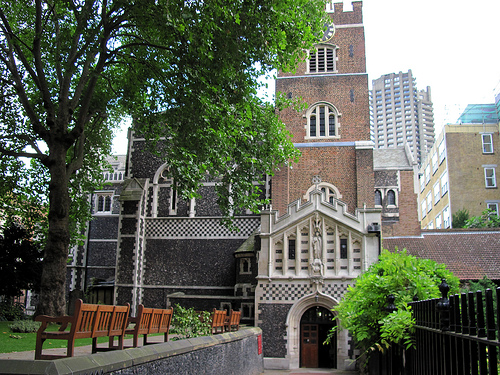St Bartholomew the Great
This has to be one of the most overlooked hidden treasures that the city has to offer. The church of St Bartholomew the Great is the oldest monastic church in the city and in parts dates back to the 12th century. Sadly there is very little of the original 12th century structure remaining, but what there is left can been found in the cloisters. This ancient church is widely regarded as being one of the finest examples of Norman architecture in the city. The church was founded in 1123 by an Augustinian monk by the name of Rahare, to be part of the priory located here. This was no ordinary monk; he was at one time the Jester in the royal court of King Henry I. Rahere found his faith after becoming so ill with malaria during a visit to Rome that he was subject to hallucinations. He claimed that it was in one such hallucination that Saint Bartholomew came to his aid and saved his life. Upon regaining his health and returning to England he made the decision to become a monk and then founded a hospital and priory dedicated to the saint who had saved his life. The church of St Bartholomew the Great was located within the walls of the priory.

Changing Times
Sadly the priory was dissolved in 1538 as were so many others at the command of Henry VIII and the buildings passed into the hands of Richard Rich who held the position of Lord Chancellor. He saw to the demolition of a large part of the priory, including part of the cloister and the church nave. What was left was used to house a stable, a smithy, a school and a wine cellar as well as a printing works which was the place of employment of one Benjamin Franklin in 1725. Much rebuilding and renovating has been carried out throughout the interceding centuries, and the church that can be viewed today is a result of works carried out between 1887 and 1928.
Visiting Today
Today you enter the church through a very pretty gateway on Little Britain Street. This gateway marks what was once the entrance to the original church. The arch way that you walk through is part of the original architecture of the church however the picturesque half timbered house which sits about the archway dates from the sixteenth century and was probably built on the orders of the Lord Chancellor Richard Rich. Through the gateway you will pass into a small green forecourt which was originally the site of the nave. The church that you find here today is only a shadow of its former self at approximately half of its original size. You will find that the Lady Chapel, a part of the transepts, the four bay choir and a single bay of the original nave are all that remain of the original building. It is however an incredibly atmospheric building which still contains the tomb of Rahare the building’s founder. The tomb was erected in 1405 and depicts the monk at prayer with an angel at his feet. There are several other notable tombs here including those belonging to members of the court of Queen Elizabeth I.

